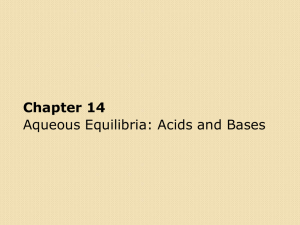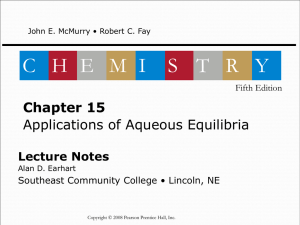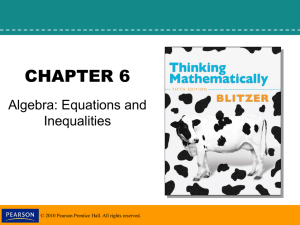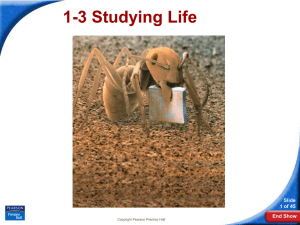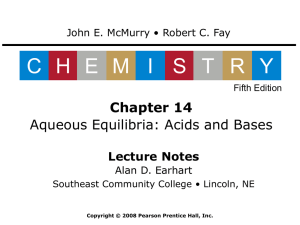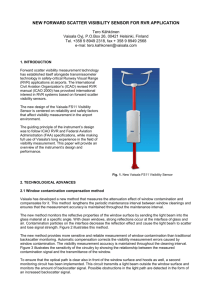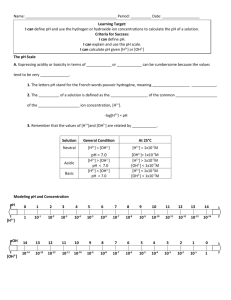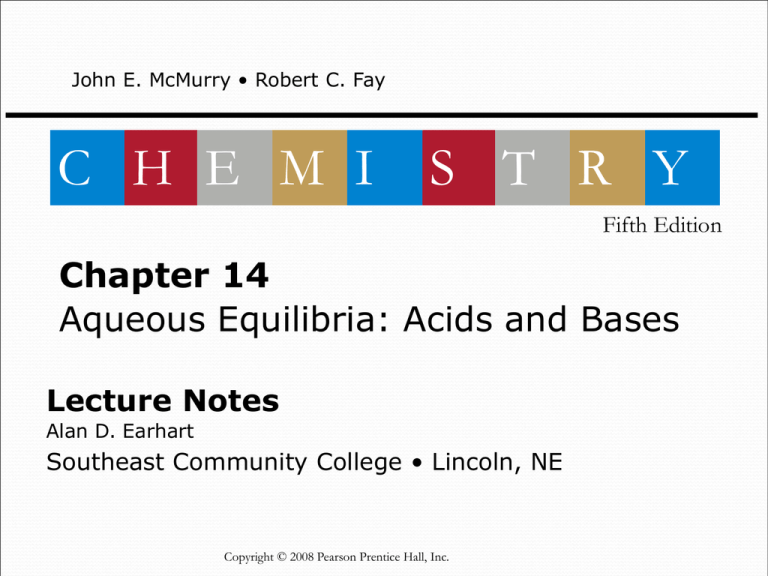
John E. McMurry • Robert C. Fay
C H E M I
S T R Y
Fifth Edition
Chapter 14
Aqueous Equilibria: Acids and Bases
Lecture Notes
Alan D. Earhart
Southeast Community College • Lincoln, NE
Copyright © 2008 Pearson Prentice Hall, Inc.
Acid-Base Concepts: The
Brønsted-Lowry Theory
Arrhenius Acid: A substance that dissociates in water to produce
hydrogen ions, H1+.
HA(aq)
H1+(aq) + A1-(aq)
Arrhenius Base: A substance that dissociates in water to produce
hydroxide ions, OH1-.
MOH(aq)
M1+(aq) + OH1-(aq)
Copyright © 2008 Pearson Prentice Hall, Inc.
Chapter
14/2
Acid-Base Concepts: The
Brønsted-Lowry Theory
Brønsted-Lowry Acid: A substance that can transfer hydrogen ions, H1+.
In other words, a proton donor.
Brønsted-Lowry Base: A substance that can accept hydrogen ions, H1+. In
other words, a proton acceptor.
Conjugate Acid-Base Pairs: Chemical species whose formulas differ only
by one hydrogen ion, H1+.
Acid-Base Concepts: The
Brønsted-Lowry Theory
Acid-Dissociation Equilibrium
Hydronium ion = H3O1+
Copyright © 2008 Pearson Prentice Hall, Inc.
Chapter
14/4
Acid-Base Concepts: The
Brønsted-Lowry Theory
Base-Dissociation Equilibrium
Copyright © 2008 Pearson Prentice Hall, Inc.
Chapter
14/5
Examples
Write a balanced equation for the dissociation of each of
the following Bronsted-Lowry acids in water
H3O+
H3PO3
Examples
Write the conjugated base for the following acids
HNO3
H2SO4
Write the conjugated acids for the following bases
CO32 PO33-
Acid Strength and Base Strength
HA(aq) + H2O(l)
Acid
Base
H3O1+(aq) + A1-(aq)
Acid
Base
With equal concentrations of reactants and products, what will be the
direction of reaction?
Stronger acid + Stronger base
Weaker acid + Weaker base
Copyright © 2008 Pearson Prentice Hall, Inc.
Chapter
14/8
Acid Strength and Base Strength
Weak Acid: An acid that is only partially dissociated in water and is thus a
weak electrolyte.
Examples
If you mix equal amount concentrations of reactants and
products, which of the following reations proceed to the
right and which proceed to the left?
H2SO4(aq) + NH3(aq)
HCO3-(aq) + SO42-(aq)
NH4+(aq) + HSO4-(aq)
HSO4-(aq) + CO32-(aq)
Hydrated Protons and
Hydronium Ions
HA(aq)
H1+(aq) + A1-(aq)
Due to high reactivity of the hydrogen ion, it is actually hydrated by
one or more water molecules.
[H(H2O)n]1+
n=1
H3O1+
n=2
H5O21+
n=3
H7O31+
n=4
H9O41+
For our purposes, H1+ is equivalent to H3O1+.
Copyright © 2008 Pearson Prentice Hall, Inc.
Chapter
14/12
Dissociation of Water
Dissociation of Water:
2H2O(l)
Ion-Product Constant for Water:
at 25°C:
[H3O1+] = [OH1-] = 1.0 x 10-7 M
Kw = (1.0 x 10-7)(1.0 x 10-7) = 1.0 x 10-14
H3O1+(aq) + OH1-(aq)
Kw = [H3O1+][OH1-]
Dissociation of Water
Kw = [H3O1+][OH1-] = 1.0 x 10-14
-14
1.0
x
10
[H3O1+] =
[OH1-]
-14
1.0
x
10
[OH1-] =
[H3O1+]
Copyright © 2008 Pearson Prentice Hall, Inc.
Chapter
14/14
Dissociation of Water
The pH Scale
pH = -log[H3
O1+]
[H3
O1+]
= 10
-pH
Basic solution: pH > 7
Neutral solution: pH = 7
Acidic solution: pH < 7
Copyright © 2008 Pearson Prentice Hall, Inc.
Chapter
14/16
The pH Scale
The hydronium ion concentration for lemon juice is
approximately 0.0025. What is the pH when [H3O1+] = 0.0025
M?
2 significant figures
pH = -log(0.0025) = 2.60
2 decimal places
Copyright © 2008 Pearson Prentice Hall, Inc.
Chapter
14/17
The pH Scale
Calculate the pH of an aqueous ammonia solution that has an
OH1- concentration of 0.0019 M.
[H3O1+] =
1.0 x 10-14
[OH1-]
=
1.0 x 10-14
0.0019
= 5.3 x 10-12 M
pH = -log(5.3 x 10-12) = 11.28
Copyright © 2008 Pearson Prentice Hall, Inc.
Chapter
14/18
The pH Scale
Acid rain is a matter of serious concern because most species of fish die in
waters having a pH lower than 4.5-5.0. Calculate [H3O1+] in a lake that has a
pH of 4.5.
[H3
O1+]
= 10
-4.5
= 3 x 10-5 M
Copyright © 2008 Pearson Prentice Hall, Inc.
Chapter
14/19
Examples
Calculate the [-OH] in a solution with [H3O+] = 7.5 x 10-5M.
Is this solution basic, acidic or neutral?
Calculate the pH of a solution with [-OH] = 8.2 x 10-10M
Calculate the concentration of H3O+ and –OH for a
solution with a pH of 8.37
Measuring pH
Acid-Base Indicator: A substance that changes color in a specific pH range.
Indicators exhibit pH-dependent color changes because they are weak
acids and have different colors in their acid (HIn) and conjugate base (In1-)
forms.
HIn(aq) + H2O(l)
H3O1+(aq) + In1-(aq)
Color A
Copyright © 2008 Pearson Prentice Hall, Inc.
Color B
Chapter
14/21
Measuring pH
Copyright © 2008 Pearson Prentice Hall, Inc.
Chapter
14/22
pH of strong acids and strong
bases
A strong monoprotic acds – 100% dissociated in aqueous
solution (HClO4, HCl, HNO3 etc…)
Contains a single dissociable proton
HA(aq) + H2O(l) H3O+(aq) + A-(aq)
pH = - log H3O+
[H3O+] = [A-] = initial concentration of the acid
Undissociated [HA] = 0
Strong Bases
Alkali metal hydroxide, MOH
Water-soluble ionic solids
Exits in aqueous solution as alkali metal cations and hydroxide
anions
Calculate pH from [-OH]
Alkaline earth metal hydroxide, M(OH)2 where M= Mg, Ca,
Sr, Ba
Less soluble than alkali hydroxide, therefore lower [-OH]
The pH in Solutions of Strong
Acids and Strong Bases
What is the pH of a 0.025 M solution of HNO3?
HNO3(aq) + H2O(l)
100%
H3O1+(aq) + NO31-(aq)
Copyright © 2008 Pearson Prentice Hall, Inc.
Chapter
14/25
The pH in Solutions of Strong
Acids and Strong Bases
What is the pH of a 0.025 M solution of NaOH?
NaOH(aq)
Na1+(aq) + OH1-(aq)
Copyright © 2008 Pearson Prentice Hall, Inc.
Chapter
14/26
Example
Calculate the pH of a solution by dissolving 0.25 g of CaO
in enough water to make 0.500L of limewater Ca(OH)2
Calculate the [-OH] and pH of 1.0 M HCl
Equilibria in Solutions of Weak
Acids
Partially ionized
HA(aq) + H2O(l)
H3O1+(aq) + A1-(aq)
Acid-Dissociation Constant:
[H3O1+][A1-]
Ka =
[HA]
Larger Ka , stronger the acid
pKa = - log Ka
Ka = antilog (- Ka) = 10-pKa
Copyright © 2008 Pearson Prentice Hall, Inc.
Chapter
14/28
Equilibria in Solutions of Weak
Acids
The pH of 0.250 M HF is 2.036. What are the values of
Ka and pKa for hydrofluoric acid?
Copyright © 2008 Pearson Prentice Hall, Inc.
Chapter
14/30
Calculating Equilibrium
Concentrations in Solution of
Weak acids
Step 1: Write the balance equation for all possible proton
transfer (both acids and water)
Step 2: Identify the principle reaction (the reaction that has
larger Ka)
Step 3: Generate an ICE table
Step 4: Solve for x
Step 5: Calculate pH and all other concentrations (HA,
H3O+ and A-)
Example
Determine the concentration of all species present (H3O+,
CH3CO2-, CH3CO2H) and pH of a 0.0100 M CH3CO2H
Ka = 1.8 x 10-5
Example
Determine the concentration of all species present (H3O+,
CH3CO2-, CH3CO2H) and pH of a 1.00 M CH3CO2H
Ka = 1.8 x 10-5
Example
Find the pH and [-OH] of a 0.100 HClO2 solution
Ka = 1.1 x 10-2
Calculating Equilibrium
Concentrations for Weak Acids
Calculate the pH of a 0.10 M HCN solution. At 25 °C, Ka
= 4.9 x 10-10.
Copyright © 2008 Pearson Prentice Hall, Inc.
Chapter
14/35
Percent Dissociation in Solutions
of Weak Acids
Percent dissociation =
[HA] dissociated
[HA] initial
x 100%
Example
Find the percent ionization of 0.100 M HClO2 solution
(previous example)
Find the percent ionization of a 2.5M HNO2 solution



